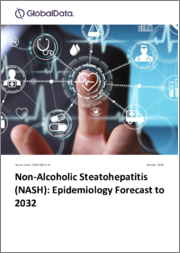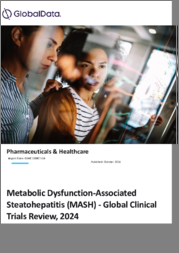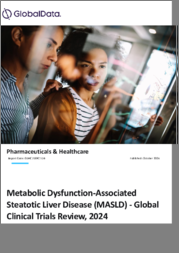
|
시장보고서
상품코드
1369490
세계의 비알코올성 지방간염(NASH) 역학 분석 및 예측(-2032년)Non-Alcoholic Steatohepatitis (NASH) Epidemiology Analysis and Forecast to 2032 |
||||||
비알코올성 지방간염(NASH)은 비알코올성 지방간 질환(NAFLD)의 아형으로 간세포 손상과 염증이 특징이며, NASH는 무증상인 경우가 많으며, 우연히 발견되는 경우가 많습니다. NASH는 간섬유화의 유무에 관계없이 발병할 수 있으며, 더 심각한 간질환으로 진행될 수 있고, NASH 환자의 20%는 간경변증이 발생하며, 모든 NASH 환자는 간세포암의 위험이 높습니다.
이 보고서는 주요 7개국(미국, 프랑스, 독일, 이탈리아, 스페인, 영국, 일본) 시장에서 비알코올성 지방간염(NASH)의 위험 요인, 동반 질환, 세계 및 과거 역학 동향을 살펴보고, 비알코올성 지방간염(NASH) 진단 사례 및 진단 진단된 유병률에 대한 10년간의 역학 예측 등을 정리했습니다.
목차
제1장 비알코올성 지방간염 : 주요 요약
제2장 역학
- 병 배경
- 위험 요인과 병존 질환
- 세계 및 과거 동향
- 주요 7개국 예측 조사 방법
- 비알코올성 지방간염 역학 예측(2022년-2032년)
- NASH 진단 증례 건수
- NASH 진단 발증 사례, 연령별
- NASH 진단 발증 사례, 성별
- NASH 진단 이환 증례, 섬유증 단계별
- NASH에 기인한 간경변 진단 증례
- 논의
- 역학 예측 인사이트
- 비만
- COVID-19의 영향
- 분석의 한계
- 분석의 강점
제3장 부록
LSH 23.11.06Abstract
Non-alcoholic steatohepatitis (NASH) is a subtype of non-alcoholic fatty liver disease (NAFLD) that is characterized by liver cell damage and inflammation (Sheka et al., 2020). NASH is often asymptomatic and is detected incidentally. A liver biopsy is required for diagnosis. NASH can occur with or without liver fibrosis and can progress to more serious liver disease. A total of 20% of NASH patients will develop cirrhosis and all NASH patients are at increased risk for hepatocellular carcinoma (Sheka et al., 2020).
Scope
- Non-alcoholic steatohepatitis report provides an overview of the risk factors, comorbidities, and the global and historical epidemiological trends for NASH in the seven major markets (7MM: US, France, Germany, Italy, Spain, UK, and Japan). The report includes a 10-year epidemiology forecast for the diagnosed prevalent cases of NASH. The diagnosed prevalent cases of NASH are segmented by age and sex. Additionally, the forecast is further segmented based on fibrosis stage and cirrhosis type. This report also provides the historical and 10-year forecasted total and diagnosed prevalent cases of NAFLD.
Reasons to Buy
The NASH Epidemiology series will allow you to -
- Develop business strategies by understanding the trends shaping and driving the global NASH markets.
- Quantify patient populations in the global NASH markets to improve product design, pricing, and launch plans.
- Organize sales and marketing efforts by identifying the age groups and sex that present the best opportunities for NASH therapeutics in each of the markets covered.
- Understand magnitude of the NASH population by age, sex, fibrosis stage, and cirrhosis type.
Table of Contents
Table of Contents
- About GlobalData
1 Non-Alcoholic Steatohepatitis: Executive Summary
- 1.1 Catalyst
- 1.2 Related reports
- 1.3 Upcoming reports
2 Epidemiology
- 2.1 Disease background
- 2.2 Risk factors and comorbidities
- 2.3 Global and historical trends
- 2.4 7MM forecast methodology
- 2.4.1 Forecast assumptions and methods
- 2.4.2 Forecast assumptions and methods: diagnosed prevalent cases of NAFLD
- 2.4.3 Forecast assumptions and methods: total prevalent cases of NAFLD
- 2.4.4 Forecast assumptions and methods: diagnosed prevalent cases of NASH
- 2.4.5 Forecast assumptions and methods: diagnosed prevalent cases of NASH by fibrosis stage.
- 2.4.6 Forecast assumptions and methods: diagnosed prevalent cases of NASH with compensated and decompensated cirrhosis.
- 2.5 Epidemiological forecast for non-alcoholic steatohepatitis (2022-32)
- 2.5.1 Diagnosed prevalent cases of NASH.
- 2.5.2 Age-specific diagnosed prevalent cases of NASH
- 2.5.3 Sex-specific diagnosed prevalent cases of NASH
- 2.5.4 Diagnosed prevalent cases of NASH by fibrosis stage.
- 2.5.5 Diagnosed prevalent cases of cirrhosis attributable to NASH.
- 2.6 Discussion
- 2.6.1 Epidemiological forecast insight
- 2.6.2 Obesity omission
- 2.6.3 COVID-19 impact.
- 2.6.4 Limitations of the analysis
- 2.6.5 Strengths of the analysis
3 Appendix
- 3.1 Bibliography
- 3.2 Primary research - high-prescriber survey
- 3.3 About the Authors
- 3.3.1 Epidemiologist
- 3.3.2 Reviewers
- 3.3.3 Vice President of Disease Intelligence and Epidemiology
- Contact Us

















